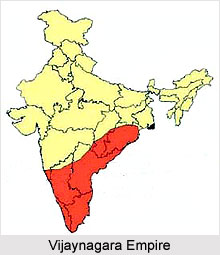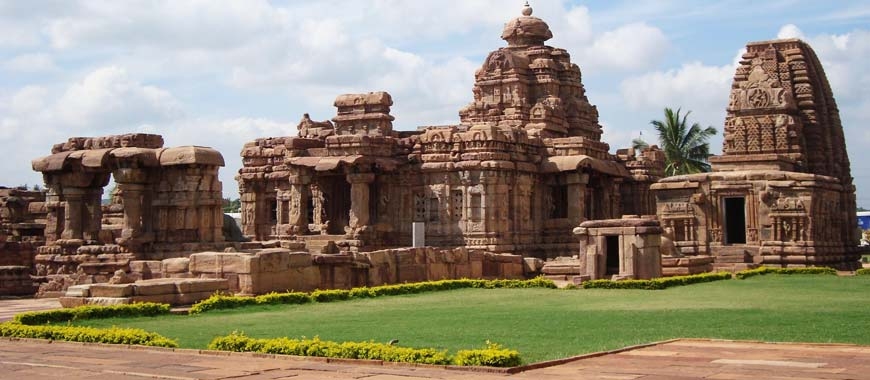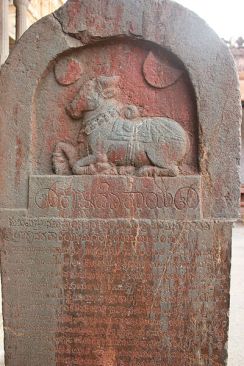The Vijayanagar empire emerged in fourteenth century India and lasted a fairly remarkable three hundred years. It was a formidable Hindu kingdom which ruled Andhra, Karnataka, Tamil Nadu, and parts of Kerala in southern India. It also governed the territories of Mysore, Trichinopally, Kanara, Pondicherry, Chingalpet and Kanchivaram. To its south was the Zamorin of Kerala, while to the north was the Bahamani sultanate of the Deccan. The empire’s now-ruined capital city of Vijayanagara can be found in the Bellary District of northern Karnataka. However, Vijayanagara is especially important because it provided a bastion of Hinduism when much of the subcontinent came under Sultanate rule. There is no doubt among historians that Hinduism would have survived in any case–after all, it remained the dominant religion in Muslim ruled North India as well–but under Hindu rule in Vijayanagara, it remained vibrant in a more pristine form philosophically, intellectually, musically, and architecturally. This is not to suggest, however, that interesting developments and fusion did not occur in North India as well.Around 1500 AD, Vijayanagara had about 500,000 citizens making it the second largest city after Beijing. It was twice the size of Paris, then.
Origin of Vijayanagar and its Foundation
Vijayanagar was a South Indian empire, founded in 1336 by Harihara I. Harihara was Bhavana Sangama’s eldest son, of the Kuruba clan of Mysore (now Karnataka), and was founder of the Sangama dynasty, the first of four Dynasties to rule the empire.An inscription indicates Harihara I as “Purvapaschima Samudradhishavara”: “The ruler of the Eastern and Western seas” showing the true establishment of the city as an empire.
The Rise of the Empire
Hoysala was on a frontier, a border between the old India and the invaders from the Sultanate Dynasty. By 1336 most of the small Hindu Kingdoms in the South had been defeated by Delhi Sultans. After the death of Hoysala Veera Ballala III the Hoysala empire merged with the growing Vijayanagar empire, which formed a solid wall against the Northern warlike Sultanates.
Four dynasties ruled over the Vijaynagar Kingdom in succession. They were:
- The Sangama dynasty (1336-1485 C.E)
- The Saluva dynasty (1485-1505 C.E)
- The Tuluva dynasty (1505-1570 C.E)
- The Aravidu dynasty (1542-1646 C.E)
KRISHNA DEVA RAYA (1509-5129)
Although it was Krishna deva raya who brought all the glory and fortune to the Vijaynagar Empire and established himself as one of the most powerful ruler of South India.He efficiently defended the Deccan from falling into the hands of the Sultanate during Medieval India.The third dyansty to rule over the Vijayanagara Empire was Tuluva Dynasty.Immadi Narasimha was murdered by Vira Narasimha who ascended the throne in 1505 and established a new dynasty called the Tuluva dynasty. He was succeeded by his famous half-brother Sri Krishna deva raya in 1509.


He possessed great military ability. His imposing personality was accompanied by high intellectual quality. His first task was to check the invading Bahmani forces. By that time the Bahmani kingdom was replaced by Deccan Sultanates. The Muslim armies were decisively defeated in the battle of Diwani by Krishna Deva Raya. Then he invaded Raichur Doab which had resulted in the confrontation with the Sultan of Bijapur, Ismail Adil Shah. But, Krishna Deva Raya defeated him and captured the city of Raichur in 1520. From there he marched on Bidar and captured it.
Krishna Deva Raya’s Orissa campaign was also successful. He defeated the Gajapathi ruler Prataparudra and conquered the whole of Telungana. He maintained friendly relations with the Portuguese. Albuquerque sent his ambassadors to Krishna Deva Raya.Though a Vaishnavaite, he respected all religions. He was a great patron of literature and art and he was known as Andhra Bhoja. Allasani Peddanna was the greatest and he was called Andhrakavita Pitamaga. His important works include Manucharitam and Harikathasaram. Pingali Suranna and Tenali Ramakrishna were other important scholars. He repaired most of the temples of south India. He also built the famous Vittalaswamy and Hazara Ramaswamy temples at Vijayanagar. He also built a new city called Nagalapuram in memory of his queen Nagaladevi. Besides, he built a large number of Rayagopurams.

Virupaksha Temple in In Hampi


Rayagopurams Architecture UNESCO world heritage site
Kannada literature
He patronised Kannada poets Mallanarya who wrote Veera-saivamruta, Bhava-chinta-ratna and Satyendra Chola-kathe, Chatu Vittal-anatha who wrote Bhaga-vatha, Timmanna Kavi who wrote a eulogy of his king in Krishna Raya Bharata. Vyasatirtha, the great saint from Mysore belonging to the Madhwa order of Udupi was his Rajaguru. Krishna Deva Rayana Dinachari in Kannada is a recently discovered work. The record highlights the contemporary society during Krishna Deva Raya’s time in his personal diary. However it is not yet clear if the record was written by the king himself.
Telugu literature
Government of India issued a stamp to commemorate Sri Krishna Deva Raya. Krishna Deva Raya’s reign is considered the golden age of Telugu literature. Eight poets known as Astadiggajalu (eight elephants in the eight cardinal points such as North, South etc.) were part of his court (known as Bhuvana-vijayamu).Krishna Deva Raya himself authored a Telugu work, Amukthamalyadha and Sanskrit works, Jambavati Kalyanam and Ushaparinayam.
Success in Deccan
The annual affair of the raid and plunder of Vijayanagar towns and villages by the Deccan sultans came to an end during the Raya’s rule. He defeated the last remnant of Bahmani Sultanate power which led to the collapse of the Bahmani Sultanate. In 1509 Krishnadevaraya’s armies clashed with the Sultan of Bijapur at Diwani and the Sultan Mahmud was severely injured and defeated. Yusuf Adil Khan was killed and the Raichur Doab was annexed. Taking advantage of the victory and the disunity of the Bahamani Sultans, the Raya invaded Bidar, Gulbarga and Bijapur and earned the title “establisher of the Yavana kingdom” when he released Sultan Mahmud and made him de facto ruler. The title advertised the boast that he was now the political arbiter of all the Deccan. The Sultan of Golconda Sultan Quli Qutb Shah was defeated by Timmarusu who was the prime minister of Sri Krishnadevaraya.
War with Feudatories
He subdued local rulers of and Velamas of Bhuvanagiri who were the feudatory of Gajapati kings of Odisha, and seized lands up to the Krishna river. Ganga Raja, the Ummatur chief, fought Krishna Deva Raya on the banks of the Kaveri and was defeated. The chief later drowned in the Kaveri in 1512. The region was made a part of the Srirangapatna province. In 1516-1517, he pushed beyond the Godavari river.
War with Kalinga
The Surya Vamsi Gajapatis of Odisha ruled a vast land comprising Andhra region, most of Telangana region, the whole of Odisha, parts of present West Bengal, Jharkhand and Chhattisgarh. Krishna Deva Raya’s success at Ummatur provided the necessary impetus to carry his campaign into the Telangana region which was in control of Gajapati Prathapa Rudra Dev. The Vijayanagar army laid siege to the Udayagiri fort in 1512. The campaign lasted for a year before the Gajapati army disintegrated due to starvation. Krishna Deva Raya offered prayers at Tirupati thereafter along with his wives Tirumala Devi and Chinnama Devi.

The Gajapati army was then met at Kondaviduraju where the armies of Vijayanagara, after establishing a siege for a few months and heavy with initial defeats began to retreat, until Timmarusu upon discovering a secret entrance to the unguarded eastern gate of the fort launched a night attack culminating with the capture of the fort and the imprisonment of the greatest swordsman of his time, Prince Virabhadra, the son of Gajapati Emperor of Kalinga-Utkal,Gajapati Prataprudra Deva. Saluva Timmarasa took over as governor of Kondavidu thereafter. The Vijayanagar army then accosted the Gajapati army at Kondapalli area and laid another siege. Krishnadevaraya then planned for an invasion of mainland Kalinga-Utkal but the Gajapati Emperor, Prataparudra, privy of this plan had built up a strategy to rout the Vijayanagara army and along with it its king, Krishnadevaraya. The confrontation was to happen at the fort of Kalinganagar. But the wily Timmarusu secured the information by bribing a Telugu deserter, formerly under the service of the mighty Prataprudra deva. Prataprudra was driven to Cuttack,the capital of the Gajapati empire and eventually surrendered to Vijaynagar, giving his daughter Princess Annapurna Devi in marriage to Sri Krishna Deva Raya.As per treaty Krishna river became boundary of Vijaynagar and Odisha Kingdom.
Krishna Deva Raya established friendly relations with the Portuguese, who set up the Portuguese Dominion of India in Goa in 1510. The Emperor obtained guns and Arabian horses from the Portuguese merchants. He also utilized Portuguese expertise in improving water supply to Vijayanagara City.
Final conflict
The complicated alliances of the empire and the five Deccan sultanates meant that he was continually at war, in one of these campaigns, he defeated Golconda and captured its commander Madurul-Mulk, crushed Bijapur and its Sultan Ismail Adil Shah and restored Bahmani sultanate to Muhammad Shah.
The highlight of his conquests occurred on 19 May 1520 where he secured the fortress of Raichur from Ismail Adil Shah of Bijapur after a difficult siege during which 16,000 Vijaynagar soldiers were killed. The exploits of the chief military commander, Pemmasani Ramalinga Nayudu, during the battle of Raichur were suitably rewarded by the grateful emperor. During the campaign against Raichur, it is said that 703,000 foot soldiers, 32,600 cavalry and 551 elephants were used (See The battle of Raichur). Finally, in his last battle, he razed to the ground the fortress of Gulburga, the early capital of the Bahmani sultanate. His empire extended over the whole of South India.
In 1524 he made his son Tirumala Raya the Yuvaraja though the crown prince did not survive for long. He was poisoned to death. Suspecting the involvement of Timmarusu, Krishna Deva Raya had his trusted commander and adviser blinded. At the same time, Krishnadevaraya was preparing for an attack on Belgaum that was in the Adil Shah’s possession; Krishnadevaraya took seriously ill. He died soon after in 1529.
Before his death, he nominated his brother, Achyuta Deva Raya as his successor. The rule of Krishnadevaraya was a glorious chapter in the history of Vijayanagara Empire. Even the ruins at Hampi tell the glorious tale of that mighty empire.
I believe my efforts and research should be acknowledged at the top of your page along with my name as the Author and not at the end of your article.
I do a lot of research work and editing and publishing my blogs so I would be glad If my efforts are Acknowledged along with my blog link on top of your post.
LikeLike